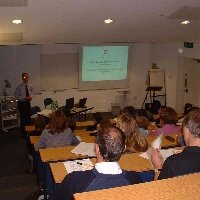Historic Environment Records


Historic Environment Records (HERs) are the mainly local authority-based services used for planning and development control. They also operate a public service and fulfil an educational role. These records were previously known as Sites and Monuments Records or SMRs. The name has changed to reflect the wider scope of the information they now contain or are aspiring to maintain.
Origins
The first SMR was established by Oxfordshire County Council in the mid 1960s, and coverage of England was completed with Kent in the 1980s. The data originated from the Ordnance Survey (OS) card index record of archaeological sites depicted on OS maps. This information was then enhanced by recording local discoveries and by documentary trawls of published information of all kinds including academic reports, journals and statutory notifications such as scheduling and listed building descriptions.
Initially SMRs were maintained using card indexes and annotated OS maps. The introduction, firstly of computerised databases and, more recently, Geographic Information Systems (GIS) has revolutionised the way these records operate.
There are over 80 HERs in England. These are mainly county council based but include joint services (i.e. more than one authority working together), district councils, unitary authorities, national parks and major landowners such as the National Trust. English Heritage maintains contact details for all English HERs on the Heritage Gateway website .
Historic Environment Records are maintained and managed by local authorities as the essential core of historic environment services. Heritage Protection Reform legislation, currently planned to go through parliament in the 2008-9 session, proposes to place a statutory duty on all county and unitary Local Authorities to host or have access to an HER and for this HER. The range of information which an HER currently captures will also extend under this new regime to cover the wider historic environment.
Uses and Users of HERs
HERs are used internally by local authorities (and authorities in a different tier of Government) for planning, development-control work and other areas of land management. They are also consulted by statutory undertakers (e.g. electricity suppliers etc) and developers in advance of planning applications. HERs have a role to play in education, being consulted by students at all levels from school children working on projects to post-graduate academic researchers. HERs operate public services for anyone interested in the archaeology, built heritage and history of an area.
As well as information for internal use with local authorities, HERs provide a range of services to the public. These vary between HERs but include:
- Dedicated desk space and a terminal
- Expert staff on hand to assist, advise and answer queries
- Remote access answering enquiries by post, telephone, facsimile and email
- Websites with interpreted information and an online version of the HER database (a growing number offer this service – see www.heritagegateway.org.uk for details)
- Outreach programmes with travelling displays, leaflets, books, newsletters and lectures
Most HERs do not charge members of the public for their services. They do, however, tend to charge commercial users for services such as staff time, photocopies and printouts.
Content of HERs
Most HERs maintain three types of record dealing with monuments, events (fieldwork such as excavation or buildings survey) and sources/archives. These are then combined in a single database with monuments and events linked to layers in a GIS.
As well as database records, HERs have physical reference collections that can be consulted, such as reports originating from archaeological and building investigations respectively as a result of conditions placed on planning applications.
Under the proposed new legislation all HERs will record as a minimum the following sets of information:
- All Registered Heritage Assets / Registered Marine Heritage Assets;
- All Locally Registered Heritage Assets including conservation areas;
- All heritage assets that are neither ‘registered’ nor ‘locally registered’ but which have known archaeological interest (whether extant or destroyed) or archaeological potential (including ‘find-spots’);
- All sites with known paleo-environmental interest;
- The archaeological, architectural and historic character of landscape;.
- All investigations of land, buildings or other structures, objects or other material for the purposes of obtaining, recording and understanding any information of archaeological or historic interest; and
- Sources that provide further information about any of the above.
Support for HERs from English Heritage
English Heritage’s lead role for HERs is co-ordinated by the National Monuments Record (NMR) based in Swindon. The NMR has a range of services for HERs such as the HER Forum which unites the HER community through co-ordination of email discussion lists, Forum meetings and news delivery through the Heritage Gateway.
The NMR also offers advice to HERs covering a range of areas and available in a variety of forms, including an on-line manual ‘Informing the Future of the Past, Guidelines for Historic Environment Records Second Edition (Eds. Gilman and Newman 2007)’, www.ifp-plus.info, data audits and advice on grants applications.
The NMR also provides a range of data and computing services for HERs including thesauri, reference data lists, NMR licences, and support for the HBSMR (HER software) user group.
Further Information
Publications
- Baker, D, 1999, An Assessment of English Sites and Monuments Records
- EH, 2006, HER Audit Specification (revised version)
- EH, 2003, Historic Environment Records: A Guide for Users
- EH, 2003, EH Response to the DCMS Consultation on Historic Environment Records
- EH & ALGAO, 2002, Historic Environment Records, Benchmarks for Good Practice
- Fernie, K. & Gilman, P. eds, 2000, Informing the Future of the Past: Guidelines for SMRs
- Fraser, D. & Newman, M., 2006, The British Archaeological Database in Hunter & Ralston
- Archaeological Resource Management in the UK, an Introduction, 2nd edition
- Gilman, P. & Newman, M eds, 2007, Informing the Future of the Past: Guidelines for Historic Environment Records (Second Edition) – electronic publication – www.ifp-plus.info
- Lee and Sundstrom (eds), 2007, Midas Heritage – the UK Historic Environment Data Standard (electronic publication – available to download at www.midas-heritage.info
- Lee, E. ed, 1998, MIDAS – A Manual and Data Standard for Monument Inventories
- Newman, M, 2001, The SMR Data Audit Programme – A Review
- Newman, M, 2002, SMR Content and Computing Survey 2002
- Howard, B, 2006, HER Content and Computing Survey 2005
External Websites
- www.heritagegateway.org.uk Heritage Gateway
- www.jiscmail.ac.uk/lists/herforum.html HER Forum email list & archive
- www.ifp-plus.info Informing the Future of the Past (Second Edition) guidelines
- www.midas-heritage.info Midas Heritage guidelines
- www.english-heritage.org.uk further information on services
- www.algao.org.uk the Association of Local Government Archaeological Officers UK
- www.ihbc.co.uk the Institute of Historic Building Conservation (IHBC)
- http://ads.ahds.ac.uk ADS, hosts online data for some HERs and offer specialist advice
- www.fish-forum.info Forum on Information Standards in Heritage, MIDAS & Inscription
- www.hlf.org.uk Heritage Lottery Fund, provides funding for HER outreach projects
For any further details contact:
- Heritage Data Management Tel:
- English Heritage Fax:
- National Monuments Record Centre Email:
- Swindon, SN2 2GZ Website: http://www.english-heritage.org.uk/professional/archives-and-collections/nmr/heritage-data/
What's New?
-
The National Heritage List for England is now live on the English Heritage website.
-
Welcome to the HER21 page. This page offers access to the full suite of HER21 project reports.
